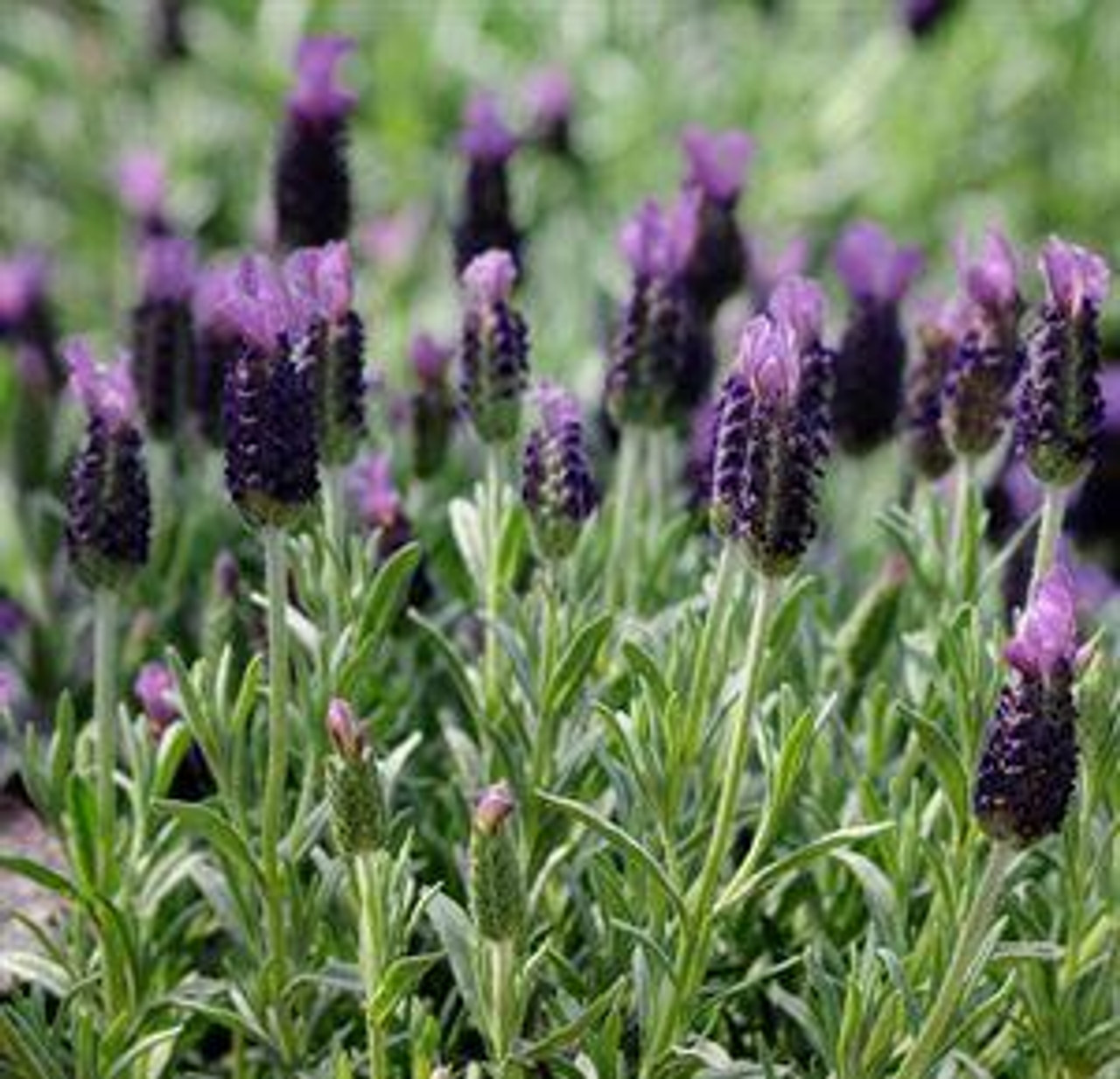Product Description
Lavandula stoechas 'Anouk' PP16685 (4) 1-gallons
Spanish Lavender
Fragrant, grey-green foliage form a bushy mound with showy purple flowers in mid-spring = summer.
This small-growing Spanish Lavender shrub is outstanding in areas with high heat and humidity
Zones 7 - 10
Full Sun
Flower Color Purple
Height 24-30" tall
Spread 24-30" wide
Soil Average
Lavandula stoechas 'Anouk' (also known as Spanish Lavender 'Anouk') is a captivating variety of lavender prized for its unique flower structure and vibrant colors. Here is a breakdown of its key features and growing requirements:
Distinctive Features:
- Flowers: 'Anouk' displays deep purple, pineapple-shaped flower heads topped with showy, violet-blue bracts (flags) that fade to pink as they mature. This striking combination creates a captivating display in the garden.
- Fragrance: The flowers and foliage possess a sweet, herbaceous fragrance, though not as strong as some other lavender varieties.
- Foliage: Soft, gray-green, needle-like foliage provides an attractive backdrop for the colorful blooms.
- Growth Habit: Compact and bushy, typically reaching 12-18 inches tall and 18-24 inches wide.
- Bloom Time: Flowers profusely in mid-to-late spring, with possible repeat blooming in fall.
Cultivation:
- Hardiness: Suitable for USDA zones 7-10. It prefers warm climates and may require winter protection in colder regions.
- Sunlight: Needs full sun (at least 6-8 hours per day) for optimal growth and flowering.
- Soil: Well-drained soil is crucial. Sandy or rocky soils are ideal. Avoid heavy clay or wet conditions.
- Water: Drought-tolerant once established. Water regularly during the first growing season, then reduce frequency.
- Pruning: Shear back lightly after flowering to maintain shape and encourage bushier growth.
Landscape Uses:
- Borders and Edging: Its compact size makes it perfect for defining garden beds and pathways.
- Rock Gardens: Thrives in well-drained, sunny conditions often found in rock gardens.
- Mediterranean Gardens: Complements other drought-tolerant plants in a Mediterranean-style landscape.
- Containers: Excellent for growing in pots on patios and balconies.
Advantages:
- Showy Flowers: The unique flower structure and vibrant colors create a stunning visual impact.
- Early Blooming: Provides early-season color in the garden.
- Heat and Drought Tolerance: Well-suited for hot, dry climates.
- Attracts Pollinators: The flowers attract bees and butterflies.
Overall, Lavandula stoechas 'Anouk' is a delightful addition to any garden that receives ample sunshine and well-drained soil. Its distinctive flowers, compact habit, and relatively low maintenance make it a favorite among gardeners.
Attract Butterflies, Deer Resistant, Rabbit Resistant
(4) 1-gallon containers ready to plant, plants maybe trimmed for shipping,
Other Details
The most important part of the plant is its root system. Healthy roots are the foundation of a healthy, vibrant plant. The type of plug container used is based on the specific needs of the plants. Perennials offered as bare root traditionally perform better when planted as bare root.Planted in a specialized mix, potted plants have well established root systems. Top growth stage will vary depending on the current life cycle and time of year when shipped. In Winter and early Spring dormant plants may be shipped. Dormant plants may be planted right away, even before the last frost date.
Most bare root varieties are field grown for at least one season, though Hemerocallis and Hosta are grown for two seasons. The bulk of the soil is removed during the harvesting process and the tops of most varieties are trimmed back to the crown. They are graded, packed in shredded aspen or sphagnum moss and stored in freezers until ready to be shipped.
See our Container Sizes and Bare Root Perennials pages for more information.
Plant information and care is provided in the Overview section, Plant Genus Page and general information is provided in the Planting Care & Guides. Additional questions can be asked on each Plant page.
Plant Spacing: Using the maximum mature spread or width of a plant to guide spacing, ensures space to grow to full size. To fill an area sooner, plant them closer together. Just remember, future thinning or transplanting may be needed.
Water: Keep a close eye on newly planted perennials, especially throughout the first growing year. Most early plant loss is due to too much or too little water!







